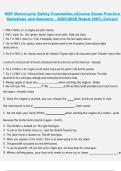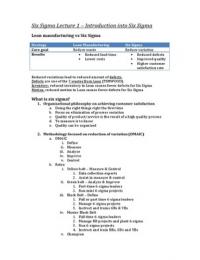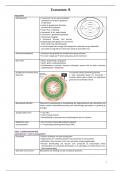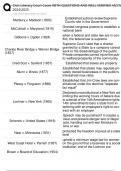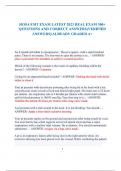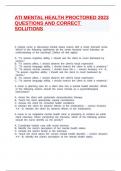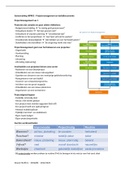DECISION MAKING IN MARKETING
LECTURE 1 – RELEVANCE OF DECISION MAKING IN MARKETING
HEURISTICS & BIASES
The illusion of decision making: are we in full control?
Default effect
- Countries with low percentage opt-in
o Check the box if you want to participate in the organ donor program
o People don’t check and don’t join
- Countries with high percentage opt-out
o Check the box if you do not want to participate in the organ donor program
o People don’t check and join
Bounded rationality: we are constraint in our decision making
- Decisions are often complex and difficult
- Individuals/consumers are bounded rational, they have to make decisions under several constraints
o Limited knowledge/information
o Limited cognitive resources (time, attention, memory)
o Limited motivation
Use of heuristics
- Heuristics = cognitive shortcuts to make decisions quickly and efficiently
- Example: default effect (people are more likely to accept default options)
- Problem use of heuristics can lead to systematic errors and biases (deviations from the true or
objective value, violation of probability laws)
Decoy effect
- Choices are made in a context
o Relative to other alternative rather than based on absolute preferences
- Decoy effect = the choice of one option over the other changes when a third – asymmetrically
dominated – option is introduced
- Asymmetrically dominated = inferior in all properties to one option, but only inferior in some
properties to the other option (an irrelevant alternative)
- Managerial relevance
o Adding an irrelevant alternative ‘helps’ consumers to decide upselling
o Examples pricing of consumer electronic products (Apple), buying popcorn in the cinema
,FURTHER HEURISTIC EXAMPLES
Anchoring and adjustment
- = making an estimation based on a process of anchoring on a salient number and adjusting up or
down
- Problem adjustments are typically insufficient, estimation is biased towards the anchor
Managerial relevance
- General negotiation (wages, prices, etc.), price expectations
- Specifically sales techniques (prices, product portfolio): furniture, cars, home appliances, etc.
Anchoring and adjustment: the discount
Mental accounting: different pockets matter
- Mental accounting = people keep track of their expenses in different mental accounts (categories);
these mental accounts influence the decision-making process
- ‘A dollar is not always a dollar’
Managerial and policy relevance
- Individuals/consumers spend money differently depending on the ‘account’ they pay from
- Examples tax refunds, birthday money, investments, bonuses at work, lottery winnings
The IKEA effect
- IKEA effect = consumers place more value on products they have (at least) partially created
- Important only if they actually finish the product
Managerial relevance
- Integrating consumers in the production process increase valuation instead of decreasing it
- However too much effort can have adverse effects
- Examples cake instant mix, customization, Build-a-Bear, ‘not invented here’
FRAMING & PROSPECT THEORY
Framing effect: preferences are about framed problems
- Preferences are about framed problems
o Winning > losing
o Winning risk averse
o Losing risk taking
- Framing effect = the frame of a message influences the decision; people react differently depending
on how a message is presented
- Two effects; (i) people prefer positive outcomes over negative outcomes, (ii) people are risk averse
over gains, but risk seeking over losses
Managerial and policy relevance
- Firing vs. saving employees: out of 600, would you rather fire 400 or save 200?
, - Health treatments: would you rather have an 90% chance to live or a 10% chance to die?
Prospect theory (Tversky & Kahneman)
Expected utility theory vs. prospect theory
- Expected utility theory (more than 275 years old)
o Utility as a function of absolute wealth
o Marginal utility decreases a wealth increase
- Prospect theory (since 1979)
o Reference dependence = value is measured in gains and losses relative to a reference point
o Diminishing sensitivity = marginal value of gains and losses decreases with their size
o Loss aversion = ‘losses loom larger than gains’
Managerial and policy relevance
- Loss aversion: potential losses motivate more than potential gains (firing vs. saving jobs, selling
insurances, structure of the tax system)
- Losses make people risk seeking (financial decision making, gambling)
LECTURE 2 – SOCIAL INFLUENCE
SOCIAL INFLUENCES IN DECISION MAKING
Social influence: we influence other and are influenced by other
‘Weapons of Influence’: techniques to persuade people/consumers
- Reciprocity and door-in-the-face
- Commitment and foot-in-the-door
- Social proof
- Scarcity
WEAPONS OF INFLUENCE
Reciprocity: give to receive
Do ut des (‘’I give that you may give’’)
, Reciprocity
- Based on the social norm to repay what another person has given to use
- Across cultures people are taught to live up to this social norm, resulting in distaste for people how
violate the norm
- Problem: exploitation of the rule as it enforces uninvited debt and can trigger unequal exchange (i.e.,
people return more than they have received)
Managerial relevance
- Sales techniques: ‘not-so-free samples’ in supermarkets, ‘gifts’ from sales persons, car tests over the
weekend etc.
- Further examples: dinner invitations, birthday presents
Indirect reciprocity: slamming the door in the face
Rejection-then-retreat
Door-in-the-face technique (DITF)
- Getting compliance to a request by starting with a large (or unreasonable) request. If the large
request is rejected, a concession will be offered (i.e., a smaller/reasonable request)
Managerial and policy relevance
- Examples: social setting (e.g., getting friends to move furniture), sales prices (e.g., bazaar)
- Works best when request is made by the same person and immediately after the first request
Commitment and consistency: stuck with a choice
- Commitment and consistency
o After making a commitment, people are more likely to agree with requests in-line with this
commitment
o Reason: people feel pressure to have consistently with their choices/commitments, as
personal consistency is highly valued by society and facilitates decision making
- Foot-in-the-door technique (FITD)
o Getting compliance to a large request by first getting agreement to a small request
o The agreement to the small request creates commitment and increases the need to be
consistent when faced with the large request
o Important: the two requests need to be similar in nature (i.e., they need to be consistent)
- Managerial relevance
o ‘Grow their own legs’: people add new reasons/justifications to support a prior commitment
o Examples: down payment (cars, holidays, furniture), newsletters, resort fees
Social proof: I do what everybody else does…
- Social proof
o People determine what to do by finding out what other people do in the same situation (i.e.,
‘’when a lot of people are doing something, it is the right thing to do’’)
o Most effective: (i) under uncertainty and (ii) with people that are similar to the decision
maker
- Managerial and policy relevance
o Peer recommendations and peer observations (important: product-in-use)
LECTURE 1 – RELEVANCE OF DECISION MAKING IN MARKETING
HEURISTICS & BIASES
The illusion of decision making: are we in full control?
Default effect
- Countries with low percentage opt-in
o Check the box if you want to participate in the organ donor program
o People don’t check and don’t join
- Countries with high percentage opt-out
o Check the box if you do not want to participate in the organ donor program
o People don’t check and join
Bounded rationality: we are constraint in our decision making
- Decisions are often complex and difficult
- Individuals/consumers are bounded rational, they have to make decisions under several constraints
o Limited knowledge/information
o Limited cognitive resources (time, attention, memory)
o Limited motivation
Use of heuristics
- Heuristics = cognitive shortcuts to make decisions quickly and efficiently
- Example: default effect (people are more likely to accept default options)
- Problem use of heuristics can lead to systematic errors and biases (deviations from the true or
objective value, violation of probability laws)
Decoy effect
- Choices are made in a context
o Relative to other alternative rather than based on absolute preferences
- Decoy effect = the choice of one option over the other changes when a third – asymmetrically
dominated – option is introduced
- Asymmetrically dominated = inferior in all properties to one option, but only inferior in some
properties to the other option (an irrelevant alternative)
- Managerial relevance
o Adding an irrelevant alternative ‘helps’ consumers to decide upselling
o Examples pricing of consumer electronic products (Apple), buying popcorn in the cinema
,FURTHER HEURISTIC EXAMPLES
Anchoring and adjustment
- = making an estimation based on a process of anchoring on a salient number and adjusting up or
down
- Problem adjustments are typically insufficient, estimation is biased towards the anchor
Managerial relevance
- General negotiation (wages, prices, etc.), price expectations
- Specifically sales techniques (prices, product portfolio): furniture, cars, home appliances, etc.
Anchoring and adjustment: the discount
Mental accounting: different pockets matter
- Mental accounting = people keep track of their expenses in different mental accounts (categories);
these mental accounts influence the decision-making process
- ‘A dollar is not always a dollar’
Managerial and policy relevance
- Individuals/consumers spend money differently depending on the ‘account’ they pay from
- Examples tax refunds, birthday money, investments, bonuses at work, lottery winnings
The IKEA effect
- IKEA effect = consumers place more value on products they have (at least) partially created
- Important only if they actually finish the product
Managerial relevance
- Integrating consumers in the production process increase valuation instead of decreasing it
- However too much effort can have adverse effects
- Examples cake instant mix, customization, Build-a-Bear, ‘not invented here’
FRAMING & PROSPECT THEORY
Framing effect: preferences are about framed problems
- Preferences are about framed problems
o Winning > losing
o Winning risk averse
o Losing risk taking
- Framing effect = the frame of a message influences the decision; people react differently depending
on how a message is presented
- Two effects; (i) people prefer positive outcomes over negative outcomes, (ii) people are risk averse
over gains, but risk seeking over losses
Managerial and policy relevance
- Firing vs. saving employees: out of 600, would you rather fire 400 or save 200?
, - Health treatments: would you rather have an 90% chance to live or a 10% chance to die?
Prospect theory (Tversky & Kahneman)
Expected utility theory vs. prospect theory
- Expected utility theory (more than 275 years old)
o Utility as a function of absolute wealth
o Marginal utility decreases a wealth increase
- Prospect theory (since 1979)
o Reference dependence = value is measured in gains and losses relative to a reference point
o Diminishing sensitivity = marginal value of gains and losses decreases with their size
o Loss aversion = ‘losses loom larger than gains’
Managerial and policy relevance
- Loss aversion: potential losses motivate more than potential gains (firing vs. saving jobs, selling
insurances, structure of the tax system)
- Losses make people risk seeking (financial decision making, gambling)
LECTURE 2 – SOCIAL INFLUENCE
SOCIAL INFLUENCES IN DECISION MAKING
Social influence: we influence other and are influenced by other
‘Weapons of Influence’: techniques to persuade people/consumers
- Reciprocity and door-in-the-face
- Commitment and foot-in-the-door
- Social proof
- Scarcity
WEAPONS OF INFLUENCE
Reciprocity: give to receive
Do ut des (‘’I give that you may give’’)
, Reciprocity
- Based on the social norm to repay what another person has given to use
- Across cultures people are taught to live up to this social norm, resulting in distaste for people how
violate the norm
- Problem: exploitation of the rule as it enforces uninvited debt and can trigger unequal exchange (i.e.,
people return more than they have received)
Managerial relevance
- Sales techniques: ‘not-so-free samples’ in supermarkets, ‘gifts’ from sales persons, car tests over the
weekend etc.
- Further examples: dinner invitations, birthday presents
Indirect reciprocity: slamming the door in the face
Rejection-then-retreat
Door-in-the-face technique (DITF)
- Getting compliance to a request by starting with a large (or unreasonable) request. If the large
request is rejected, a concession will be offered (i.e., a smaller/reasonable request)
Managerial and policy relevance
- Examples: social setting (e.g., getting friends to move furniture), sales prices (e.g., bazaar)
- Works best when request is made by the same person and immediately after the first request
Commitment and consistency: stuck with a choice
- Commitment and consistency
o After making a commitment, people are more likely to agree with requests in-line with this
commitment
o Reason: people feel pressure to have consistently with their choices/commitments, as
personal consistency is highly valued by society and facilitates decision making
- Foot-in-the-door technique (FITD)
o Getting compliance to a large request by first getting agreement to a small request
o The agreement to the small request creates commitment and increases the need to be
consistent when faced with the large request
o Important: the two requests need to be similar in nature (i.e., they need to be consistent)
- Managerial relevance
o ‘Grow their own legs’: people add new reasons/justifications to support a prior commitment
o Examples: down payment (cars, holidays, furniture), newsletters, resort fees
Social proof: I do what everybody else does…
- Social proof
o People determine what to do by finding out what other people do in the same situation (i.e.,
‘’when a lot of people are doing something, it is the right thing to do’’)
o Most effective: (i) under uncertainty and (ii) with people that are similar to the decision
maker
- Managerial and policy relevance
o Peer recommendations and peer observations (important: product-in-use)

